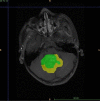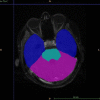Deep learning based clinico-radiological model for paediatric brain tumor detection and subtype prediction
- PMID: 37720352
- PMCID: PMC10501890
- DOI: 10.37349/etat.2023.00159
Deep learning based clinico-radiological model for paediatric brain tumor detection and subtype prediction
Abstract
Aim: Early diagnosis of paediatric brain tumors significantly improves the outcome. The aim is to study magnetic resonance imaging (MRI) features of paediatric brain tumors and to develop an automated segmentation (AS) tool which could segment and classify tumors using deep learning methods and compare with radiologist assessment.
Methods: This study included 94 cases, of which 75 were diagnosed cases of ependymoma, medulloblastoma, brainstem glioma, and pilocytic astrocytoma and 19 were normal MRI brain cases. The data was randomized into training data, 64 cases; test data, 21 cases and validation data, 9 cases to devise a deep learning algorithm to segment the paediatric brain tumor. The sensitivity, specificity, positive predictive value (PPV), negative predictive value (NPV), and accuracy of the deep learning model were compared with radiologist's findings. Performance evaluation of AS was done based on Dice score and Hausdorff95 distance.
Results: Analysis of MRI semantic features was done with necrosis and haemorrhage as predicting features for ependymoma, diffusion restriction and cystic changes were predictors for medulloblastoma. The accuracy of detecting abnormalities was 90%, with a specificity of 100%. Further segmentation of the tumor into enhancing and non-enhancing components was done. The segmentation results for whole tumor (WT), enhancing tumor (ET), and non-enhancing tumor (NET) have been analyzed by Dice score and Hausdorff95 distance. The accuracy of prediction of all MRI features was compared with experienced radiologist's findings. Substantial agreement observed between the classification by model and the radiologist's given classification [K-0.695 (K is Cohen's kappa score for interrater reliability)].
Conclusions: The deep learning model had very high accuracy and specificity for predicting the magnetic resonance (MR) characteristics and close to 80% accuracy in predicting tumor type. This model can serve as a potential tool to make a timely and accurate diagnosis for radiologists not trained in neuroradiology.
Keywords: Deep learning model; artificial intelligence; brainstem glioma; ependymoma; medulloblastoma; paediatric brain tumors; pilocytic astrocytoma.
© The Author(s) 2023.
Conflict of interest statement
The authors declare that there is no conflict of interest.
Figures







Similar articles
-
Znet: Deep Learning Approach for 2D MRI Brain Tumor Segmentation.IEEE J Transl Eng Health Med. 2022 May 23;10:1800508. doi: 10.1109/JTEHM.2022.3176737. eCollection 2022. IEEE J Transl Eng Health Med. 2022. PMID: 35774412 Free PMC article.
-
Deep Learning for Pediatric Posterior Fossa Tumor Detection and Classification: A Multi-Institutional Study.AJNR Am J Neuroradiol. 2020 Sep;41(9):1718-1725. doi: 10.3174/ajnr.A6704. Epub 2020 Aug 13. AJNR Am J Neuroradiol. 2020. PMID: 32816765 Free PMC article.
-
Multimodal MRI Image Decision Fusion-Based Network for Glioma Classification.Front Oncol. 2022 Feb 24;12:819673. doi: 10.3389/fonc.2022.819673. eCollection 2022. Front Oncol. 2022. PMID: 35280828 Free PMC article.
-
Magnetic Resonance Imaging in the Contemporary Management of Medulloblastoma: Current and Emerging Applications.Methods Mol Biol. 2022;2423:187-214. doi: 10.1007/978-1-0716-1952-0_18. Methods Mol Biol. 2022. PMID: 34978700 Review.
-
A Comprehensive Analysis of Recent Deep and Federated-Learning-Based Methodologies for Brain Tumor Diagnosis.J Pers Med. 2022 Feb 13;12(2):275. doi: 10.3390/jpm12020275. J Pers Med. 2022. PMID: 35207763 Free PMC article. Review.
Cited by
-
Deep learning-driven brain tumor classification and segmentation using non-contrast MRI.Sci Rep. 2025 Jul 30;15(1):27831. doi: 10.1038/s41598-025-13591-2. Sci Rep. 2025. PMID: 40745383 Free PMC article.
-
Enhancing diagnosis of Hirschsprung's disease using deep learning from histological sections of post pull-through specimens: preliminary results.Pediatr Surg Int. 2023 Nov 29;40(1):12. doi: 10.1007/s00383-023-05590-z. Pediatr Surg Int. 2023. PMID: 38019366 Free PMC article.
-
Deep learning strategies for semantic segmentation of pediatric brain tumors in multiparametric MRI.Sci Rep. 2025 Jul 2;15(1):22595. doi: 10.1038/s41598-025-07257-2. Sci Rep. 2025. PMID: 40596219 Free PMC article.
References
-
- Lacayo A, Farmer PM. Brain tumors in children: a review. Ann Clin Lab Sci. 1991;21:26–35. - PubMed
LinkOut - more resources
Full Text Sources
Research Materials
